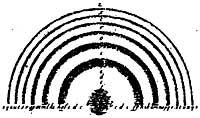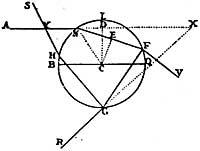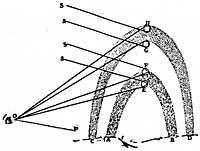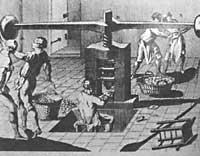Newton and optics
1987/08/01 Etxebarria, Jose Ramon Iturria: Elhuyar aldizkaria
1. When and how he wrote OPTIKA.
As happened with the origin of the work of other areas, in this case also the beginning of the link with Newton's Optics should be placed in the retirement that began with the epidemic, around 1666, at the age of twenty-three. Then, in 1669, we have been converted into Optics Professors, and in 1672, being a "Fellow", on 8 February he read and presented in the Royal Society a work on light under the title "A new theory of light and colors". This scientific society asked Hooke a report on this work, which provoked a strong controversy, in which also participated Huygens, Pardies and others, which lasted for three or four years.
On December 9, 1675, he again presented a new paper in the Royal Society entitled "Explanatory Hypotheses of the Properties of Light" and on January 20 of the following year "Discourse of Specifications". In 1703 he was appointed president of the Royal Society and died Hooke, his critic. In 1704 the first edition of Optika was published, since Newton was 62 years old.
The full title of the work is "Optics, or Treatise on reflections, refractions, inflection and colors of light", divided into three books. In the introductory note dated 1 April 1704, Newton himself acknowledged that if he postponed the publication until then, he was “not to find it involved in discussions”. Residing, he made two other publications in English in the years 1717 and 1721, introducing some modifications in each of them, and after his death in 1727, adding some of his notes, in 1730 a new edition was made. In addition to the English, they were also published in Latin while living.
2. Theory of light when arriving at Newton.
To understand the scope of Newton's contribution to the theory of light, it is appropriate, even briefly, that the dominant opinions appear among scientists during his contribution. In fact, then the ideas of Descartes were accepted, and according to them the light was a type of pressure, a tendency to movement, which was proposed in a fluid medium, and the colors were only changes in that original pulse which is the nature of the light.
That is, with Descartes there was a mechanistic explanation of light, explaining phenomena related to light as matter and motion, as a kind of mechanical wave, but always discarding the essential qualities of the light itself. The qualities were explained by the movement of the particles of the area. Descartes, for his part, presented three additional models or hypotheses, different in fact and contradictory to each other, to explain the nature and properties of light.
The first hypothesis was designed to explain the direct path of light, the second to explain the capacity of the rays to cross each other without disturbing, and the third was a corpuscular model of light to explain reflection and refraction by rebounds and turns of particles. In any case, light was considered a homogeneous pulse, although the third hypothesis was contradictory.
Thus things, Newton bought a prism in 1664 to make several attempts on the phenomena of colors. In the sense of Newton, the fundamental phenomenon of light is that of direct propagation, which leads in a way to a position contrary to the wave model, since being a pulse or pressure expanded in a fluid, the light should surround the obstacles, inclining towards the shade, as it happens with the sound or the surface waves of the water. According to Newton, direct expansion could only be explained when light is formed by small corpuscles that, coming out of the light source, expand through space. And this view is reinforced by the appearance of a heterogeneous composition of white light after experimentum crucis in 1672.
3. Method used in OPTICS.
In his work Newton distances himself from the previously broken path in the book "Principia", so it may be interesting to make some observations on the method used.
3.1. Nature of the OPTICS.
Optics is composed of three books. The first book begins with the following positivist statement: "In this book I do not want to explain the properties of light through hypotheses, but demonstrate them through reasoning and experiments." For this purpose it gives a special structure to the book.
In fact, after a series of definitions (what are light rays, what are reflection and refraction, ...) it presents some axioms (which are the laws of reflection and refraction) and from there it gives a series of proposals/theorems one by one, providing experimental tests in each case, presenting some experiments (with their assembly and their consequences) and ending with the notes that are called scolios to explain the conclusions. In this way, the proposals are presented again and again, combining them in some cases -- mostly -- with a theorem and in others with a problem.
In the second book he modifies somewhat the objective and presents observations in the first two sections, in the third section to make proposals, but always based on previous observations.
In his third book, once the observations have begun, he puts in the air twenty-six unresolved questions, since, according to him, «lack of adequate experiments to solve these problems».
3.2. Differences between the methods of the books OPTICS and PRINCIPIA.
As discussed in the previous point, it is easy to see the differences between these two great works by Newton. The "Principia" is a finished and circular work, which can only be read by people very trained in the field of Mathematics and, in short, a systematic synthesis of problems previously known as the laws of Kepler. Optics, however, is an open job, an experimental work in a field under construction, so it ends with some questions.
The "Beginning" is, in some way, the end of the revolution in the field of Dynamics, and therefore the XIX. The analytical formulation of the twentieth century remains intact until its arrival. However, with optics a new path is opened, organizing an experimental method, using a language understandable for many people, and making a detailed description of the experiments, offering the possibility that any other can repeat them.
3.3. Theories against hypotheses: Experimentum crucis.
In Newton's letter to the secretary of the Royal Society, experimental argumentation in the construction of a theory is systematically used. To anything, novelty does not reside in the use of experiments, but in the express preparation of experiments for the demonstration of a theory.The starting point of the study is the result of an observation that, after refracting in a prism, analyzes the abnormal extension of the image of a circular hole. This phenomenon was unexpected according to the laws of geometric optics, but to explain it, always accepting the homogeneous character of light, four additional hypotheses were made. Newton's work is based on rejecting these four hypotheses, organizing for it appropriate and independent experiments, thus demonstrating that these hypotheses are false.
In any case, Newton realized that the new hypotheses could be invented constantly to understand the problems. That is why he organizes experimentum crucis to show that the theory itself is not correct and that his heterogeneous theory (that is, that in sunlight there are different types of rays) is correct.
Let's see what this experimentum crucis consists of (Book 1, Chapter 1, II. Proposition II. theorem, experiment 6). The experimental assembly is done by two boards and two prisms with a hole, as indicated in figure 1 attached. Once the light has been refracted in the first prism, the beam corresponding to a color is selected through holes in the tables, going to the prism located after the second hole. With the rotation of the first prism you can choose one color or another. Thus, he saw that the light that was most refractory in the first prism (blue) was the one that most refracted in the second, equally.
Repeating the experiment and always obtaining the same result, it was clear that it was in favour of a heterogeneous theory, and in Newton's words two propositions/theorems were demonstrated: «I. Proposition. I. Theorem: The lights of different colors have different degree of refraction ». «II. Proposition. II. Theorem: The sunlight is formed by rays with different degrees of refraction».
In this key experiment it is demonstrated, therefore, that the dispersion of light is due to the fact that white light is not homogeneous and that refraction does not alter properties. The prism is not a modifier of light, but an analyzer. In the same way, seeing that at each level of refraction a color corresponds to it, he led to thinking that the colors are the original properties of the rays, which reinforced the belief that the rays are of expansive nature, since only one body could have fixed properties, which was against the movement of the medium defended by Newton's rivals.
4th Reaction of the physicists of Newton's time.
At the end of his work Newton asked the Royal Society to drive such experiments, but as we will see, his overall response was surprising and painful to her. In fact, he presented a theory that critics considered as hypotheses.
The Royal Society commissioned Hooke to elaborate a report on Newton's work, and in his observations appeared some desepticism. Despite his excellent work, he considered Newton's theory as an imaginary hypothesis. Similarly, Pardies explained that to understand these phenomena, other explanations could be given. For his part, Huygens considered it plausible (vraysemblable), but then claimed that he could devise two or three different hypotheses.
However, what at first was a scientific debate, was screamed, especially with the vicissitudes of Hooke with Newton on the theory of gravitation in 1679, by which in Principia did not even mention Hooke. And as a result of these discussions, Newton delayed the publication of the book Optics until 1703 Hooke died, thus avoiding the risk of debate. Huygens had already died in 1695.
However, it is interesting to highlight the essence of the debate. At that time, by influence of Bacon, moving away from the mathematical sciences that came from classical times, an experimentalist attitude appeared in the natural sciences. Consequently, the hypotheses were taken in a non-conceptual manner and thus Newton's claims of light were terrible. In fact, Hooke's central argument was against the dogmatism which expressed that Newton's theory was completely proven, and in this way his intention was not to prove that both of Newton was false, but to prove that it was only one of the possible hypotheses.
That is, Hooke's aim was to consider that work as a hypothesis, denying the claim to be theory. This is what Hooke said: "What I say should not be considered a critique of his theory, because it is a hypothesis with which I agree on all sides and I think it is very subtle and visionary, capable of explaining all the phenomena of colors. However, I cannot believe that it is the only possible hypothesis, nor that it is as real as mathematical tests».
Newton, on the contrary, does not attend to it and force in the falsity of the theory of others: "In my opinion, the fundamental assumption is to propagate the waves or vibrations of a fluid in the mode of rectilinear lights, without being dispersed in all directions through the environment that surrounds it and without a constant deterioration".
Therefore, Hooke, Pardies and Huygens criticize the Newtonian method and its dogmatic method to present the discoveries. Newton's response, however, is substantive, repeatedly rejecting the hypotheses of his competitors and arguing his theory. In depth there are communication problems, since it is discussed from very different positions.
5. Contributions of Newton to Optics.
Although many experiments are exposed in the intense work of optics and proposed theorems, here we will only mention some that we can consider as main contributions.
5.1. The white light is formed by different colors.
Bolstering in the experimentum crucis described earlier in point 3.3, he discovered the heterogeneous character of light. As we have said, with the first prism I achieved the sprectro of the white light and from there I selected a narrow arc of monochromatic light. When this monochromatic light was passed through the second prism, it deviated, but suffered no other change. In this way, he concluded that white light was a mixture of rays of different colors, each with a specific degree of refraction.
5.2. Reflection telescope.
According to the results of the previous experiment, Newton realized that telescopes made with simple lenses had limits and thus explained the problem of chromatic aberration.
As he said (VII. Proposition. VI. Theorem), «The different levels of refraction of light rays prevent the perfection of the telescopes». To understand the essence of Newton's reasoning, we can consider a convex lens as a set of two prisms that are played at the base (see Figure 2). In it it is easily seen that each color will have its focus and, therefore, a poor image of the cause of this chromatic aberration will be obtained.
To overcome this problem, Newton proposed a new type of telescopes. In his opinion, «Aware of the impossibility of improving telescopes of a length being of refraction, I have invented a tool of reflection... ». Figure 3 shows the scheme of the telescope invented by Newton, as he did in his book.
As seen, at the bottom of the long tube with the black inner surface is placed a spherical mirror that allows concentrating the rays and carrying them to the eyepiece through the rectangular prism. This type of telescopes acquired great importance in the next century W. From the hand of Herschel.
5.3. Rings of Newton.
In the second book of the optics work, in the observations on reflection, refraction and colours of fine transparent bodies, we describe the current phenomenon called Newton rings and the explanation of why (although the latter is not correct, since we must take into account interferences for the real explanation, the wave model). This phenomenon occurs when the light crosses a thin film of air, as is the case of the surface laun of glass AB of Figure 5 and the spherical surface CDE (the spherical surface being that of a convex lens).
In the images that appeared in his optics work, the first one describes the rings (4. Image) and second (5. Image) the explanation provided, according to which the rings are formed by alternation between the transmission and reflection that occurs on the curved surface.
5.4. Explanation of the rainbow.
The approach to the problem is as follows: «IX. Proposition. IV. Problem: Problem: From the properties of the light found, explain why the colors of the rainbow». After making known in this section some of the studies of his predecessors (Descartes himself explained it in part in his book Les Météores), he relates these results with the explanation of the composition of light, explaining and fixing the origin of the rainbow and the nature of its colors. Thus, figures 6 and 7 are those presented in his work.
5.5. Newton had some problems.
As for the nature of light, Newton did not seem clear for a long time. Was it gorpuscular in character or, as most of its time believed, was a wave that expanded into a medium that occupied all space? In fact, in the questions of the third book of Optics implicitly uses both forms of being, but more and more resorted to the defense of the corpuscular model.
The biggest obstacle I had to accept the wave model was the direct diffusion of light, since the waves surround the obstacles. Phenomena similar to those of light were not known in their day, although in 1665 F.M. Grimaldi, in the shade of a pile, observed his lights and shadows. But the diffraction would be understood one hundred and fifty years later. However, Newton's rings were interfering images, but he gave another explanation to this phenomenon.
The case of polarization, which could be the defense of the wave model, considered it as an argument contrary to it. In fact, Huygens discovered this phenomenon with the sword crystals brought from Iceland, but since Newton had scalar waves in his head, polarization became incomprehensible in the wave model.
Also in the explanation of the refraction, when explaining the law of Snell, are obtained theoretically reverse relations with both models for the ratio between the sinuses of the angles: if in the corpuscular model the ratio v 2 /v 1 is obtained, in the wave model v 1 /v 2. In other words, the corpuscular model predicts a higher speed in denser media and the wave model to the reverse, so its standard could be determined between both models. However, this criterion did not serve to decide between the two models, since the speed of light was too high and the efforts to measure it failed. Therefore, the problem was left unsolved.
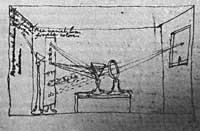
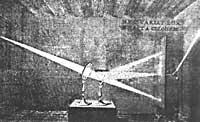
Not forgetting the work done by Hooke and Huygens, with the scientific prestige of Newton in his later years and, in general, in the XVIII. In the nineteenth century the corpuscular model was imposed until the nineteenth. Until the appearance in the eighteenth century of works such as Young, Fresnel or Fraunhofer.
6th As a final.
Although each of the above-mentioned contributions is enough to extol the name of a scientist, of course, scientist Newton, able to do all of them, has occupied a special place in the history of Physics. And I say the scientist Newton, because only from a scientific point of view serves me as an example. The man of Newton can not take it as a model, because besides being a cypress man, indigent, selfish, etc., in 1697, only in the environment of London, in the accusation of being a forger led nineteen people to hanged without mercy.

Gai honi buruzko eduki gehiago
Elhuyarrek garatutako teknologia







